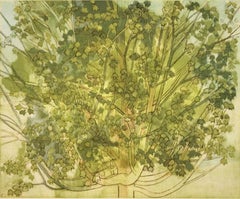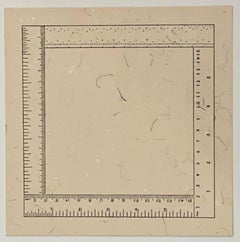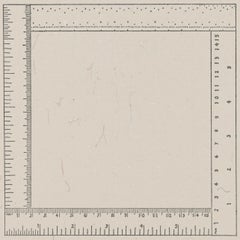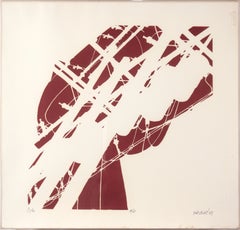Sylvia Plimack Mangold Art
to
1
2
1
Overall Width
to
Overall Height
to
2
1
2
1
1
2
1
1
1
1
1
1
1
1
1
1
3
9,959
2,747
1,368
1,366
3
Artist: Sylvia Plimack Mangold
Summer Maple
By Sylvia Plimack Mangold
Located in New York, NY
A drypoint and aquatint by artist Sylvia Plimack Mangold.
Category
21st Century and Contemporary Sylvia Plimack Mangold Art
Materials
Drypoint
Six Inches Four Ways in the original colophon envelope, pencil numbered 917/1000
By Sylvia Plimack Mangold
Located in New York, NY
Sylvia Plimack Mangold
Six Inches Four Ways
1976
Rubber stamp print on Kilmurray paper
Stamp made by Unity Engraving Company, Inc.
Printed by A. Colish Press
Paper size: 8 x 8 inches...
Category
1970s Abstract Sylvia Plimack Mangold Art
Materials
Lithograph
Six Inches Four Ways, Rubber Stamp Portfolio, Sylvia Plimack Mangold
By Sylvia Plimack Mangold
Located in Southampton, NY
Printer’s ink from rubber stamp on vélin Kilmurray paper. Paper Size: 8 x 8 inches. Inscription: Unsigned, as issued. Notes: From the folio, Rubber Stamp Portfolio, 1977. Published b...
Category
1970s Minimalist Sylvia Plimack Mangold Art
Materials
Printer's Ink
Related Items
Notre-Dame Cathedral from the Seine
Located in Middletown, NY
Etching with drypoint on cream wove paper, 7 x 8 3/4 inches (177 x 223 mm); sheet 10 1/2 x 11 3/4 inches (267 x 300 mm), full margins. Signed V. E. Chapel and numbered 62/250 in penc...
Category
Early 20th Century French School Sylvia Plimack Mangold Art
Materials
Etching, Drypoint
"Poles" Minimalist Abstract Lithograph on Paper
By Arnold Mesches
Located in Soquel, CA
"Poles" Minimalist Abstract Lithograph on Paper
Bold abstracted lithograph by Arnold Mesches (American, 1923-2016). Negative space is filled in wi...
Category
1960s Minimalist Sylvia Plimack Mangold Art
Materials
Paper, Ink, Lithograph
$1,150
H 30 in W 31.25 in D 1.5 in
Kalithea - Lithograph by Piero Dorazio - 1977
By Piero Dorazio
Located in Roma, IT
Kalithea is an original print realized by Piero Dorazio in 1977.
Mixed color lithograph on paper.
Hand-signed in pencil on the lower right. Numbered on the lower left. Edition of 1...
Category
1970s Abstract Sylvia Plimack Mangold Art
Materials
Lithograph
Hand-Gilded-Constant Gardener-Artist Proof-Rare X-Large-British Awarded Artist
Located in London, GB
This is an unique one-off Artist Proof, in a rare Extra-Large square format.
A special Proof that only 3 have been made with hand gilded Gold Leaf.
The outstanding hand-painted qua...
Category
2010s Abstract Expressionist Sylvia Plimack Mangold Art
Materials
Gold Leaf
$526
H 39.38 in W 39.38 in D 0.04 in
After Turner-One Off, Proof No 1-British Awarded Artist-Seascape-river Thames
Located in London, GB
This is a large Artist's Proof with original oil and gesso paint highlighting; it is the No 1 of the only 3 Proofs; the colours of the painting and Shizico's expressive brushstrokes ...
Category
2010s Abstract Expressionist Sylvia Plimack Mangold Art
Materials
Archival Ink, Acrylic, Oil, Gesso, Archival Paper, Giclée
$607
H 39.38 in W 27.56 in D 0.04 in
Hand Painted Large-Gladiolus Glorious-British Awarded Artist-Limited Edition#7
Located in London, GB
This rare X-large Limited Edition is 80% hand painted and highlighted with original paint and brushstrokes painted by artist Shizico Yi.
Only 10 Limited Edition has been made, last ...
Category
2010s Abstract Impressionist Sylvia Plimack Mangold Art
Materials
Gesso, Archival Ink, Acrylic, Archival Paper, Giclée, Oil
$513
H 31.5 in W 47.25 in D 0.04 in
Werner Bronkhorst - Tip Of The Iceberg
Located in London, GB
Werner Bronkhorst
Sail Away, 2025
Giclée print on 310gsm Smooth Cotton Rag using Epson archival inks
Shadow box framed in FSC certified timber with a smooth white finish and 3mm mu...
Category
2010s Contemporary Sylvia Plimack Mangold Art
Materials
Archival Ink, Giclée
$3,456 Sale Price
20% Off
H 17.72 in W 13.78 in
Chicago Skyline
By Paul Schumann
Located in Middletown, NY
A beautiful turn-of-the-century lake view of Chicago by an American artist known for his Texas landscapes.
Etching with drypoint on watermarked Umbria laid paper with deckle edges, 7 1/4 x 10 7/8 inches (182 x 275 mm), full margins. Signed and numbered 4/25 in pencil, lower margin. In good condition with adhesive residue at the sheet edges on the verso, does not show through to the recto. A lovely Lake Michigan landscape...
Category
Early 20th Century American Modern Sylvia Plimack Mangold Art
Materials
Handmade Paper, Etching, Drypoint
Hand-Painted Large Artist Proof-Summer Night-British Awarded Artist-One Off
Located in London, GB
This stunning Artist's Proof is an one-off, oil hand-painted, signed at front and on the back label too; each proof is 80% hand painted by Shizico Yi, because the nature of hand mixe...
Category
2010s Abstract Expressionist Sylvia Plimack Mangold Art
Materials
Gesso, Archival Ink, Oil, Acrylic, Archival Paper, Giclée
$513
H 47.25 in W 31.5 in D 0.04 in
"The Sun Shines All Over", Vintage Geometric Abstract Landscape Screen Print
By Xiu-ping Liao
Located in Soquel, CA
"The Sun Shines All Over", a bold minimalist vintage abstract landscape print by the renowned printmaker Shiou-ping Liao (Taiwanese, b.1936). A perfectly circular, high voltage rainb...
Category
1960s Abstract Geometric Sylvia Plimack Mangold Art
Materials
Paper, Printer's Ink, Screen
$825
H 16.25 in W 20.25 in D 0.75 in
Cortland Street
Located in Middletown, NY
Etching with drypoint on antique handmade laid Japon paper, 12 7/8 x 7 1/2 (327 x 191 mm); sheet 15 5/16 x 10 7/16 (389 x 265 mm), full margins. Signed in pencil in the lower margin....
Category
Early 20th Century American Modern Sylvia Plimack Mangold Art
Materials
Etching, Drypoint
Hand Painted Rosarian series-Aluminium Limited Edition-British Award Artist
Located in London, GB
Summer Bloom series began in 2022, where Shizico Yi celebrating the season by painting en plein air in her garden. In 2024, she embarks on a fresh chapter with her new rose garden. T...
Category
2010s Abstract Expressionist Sylvia Plimack Mangold Art
Materials
Metal
$268
H 15.75 in W 11.82 in D 0.12 in
Sylvia Plimack Mangold art for sale on 1stDibs.
Find a wide variety of authentic Sylvia Plimack Mangold art available for sale on 1stDibs. If you’re browsing the collection of art to introduce a pop of color in a neutral corner of your living room or bedroom, you can find work that includes elements of green and other colors. You can also browse by medium to find art by Sylvia Plimack Mangold in drypoint, engraving, aquatint and more. Not every interior allows for large Sylvia Plimack Mangold art, so small editions measuring 24 inches across are available. Customers who are interested in this artist might also find the work of Elizabeth Catlett, Yvonne Jacquette, and Frank Romero. Sylvia Plimack Mangold art prices can differ depending upon medium, time period and other attributes. On 1stDibs, the price for these items starts at $6,000 and tops out at $6,000, while the average work can sell for $6,000.




